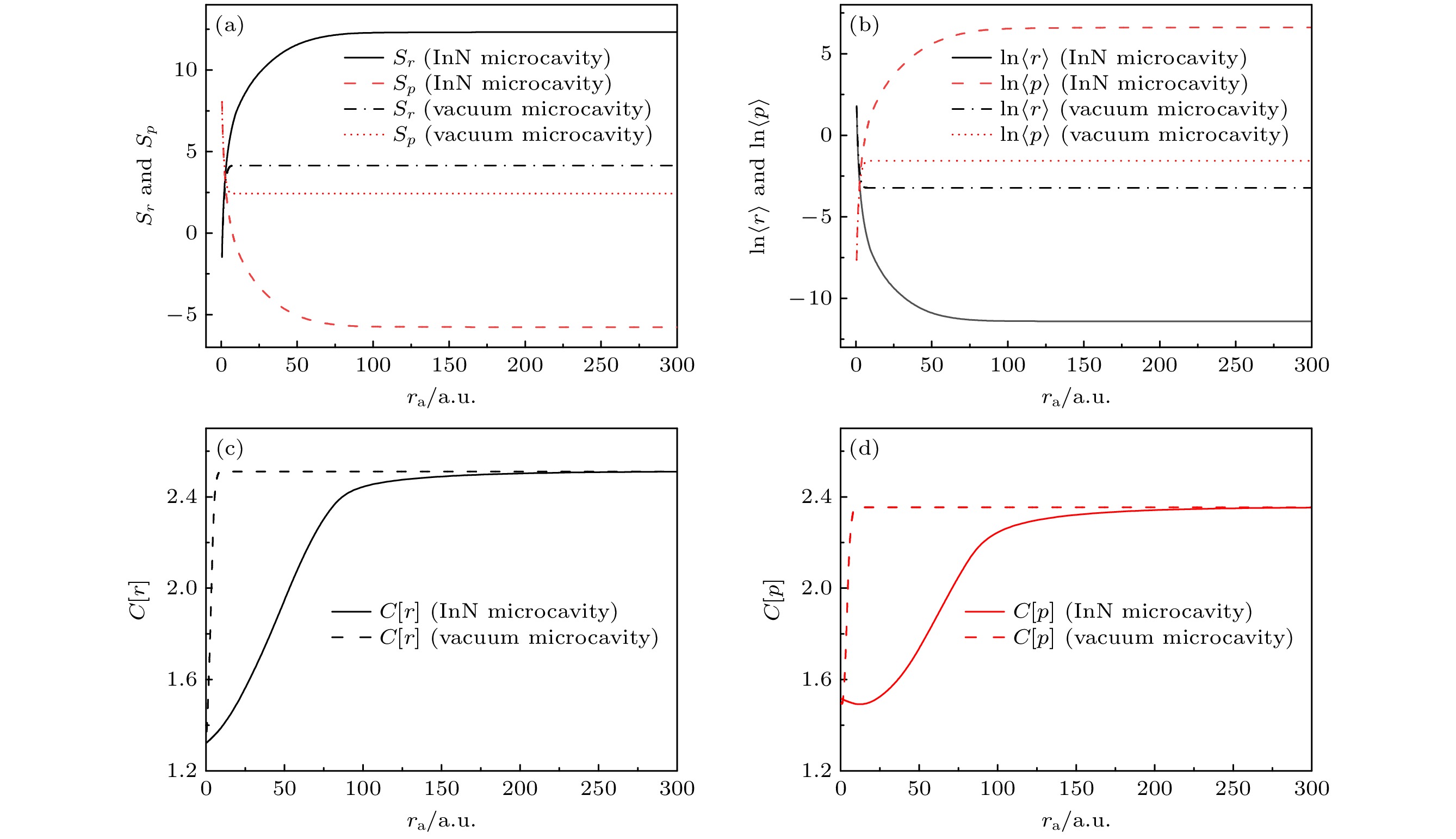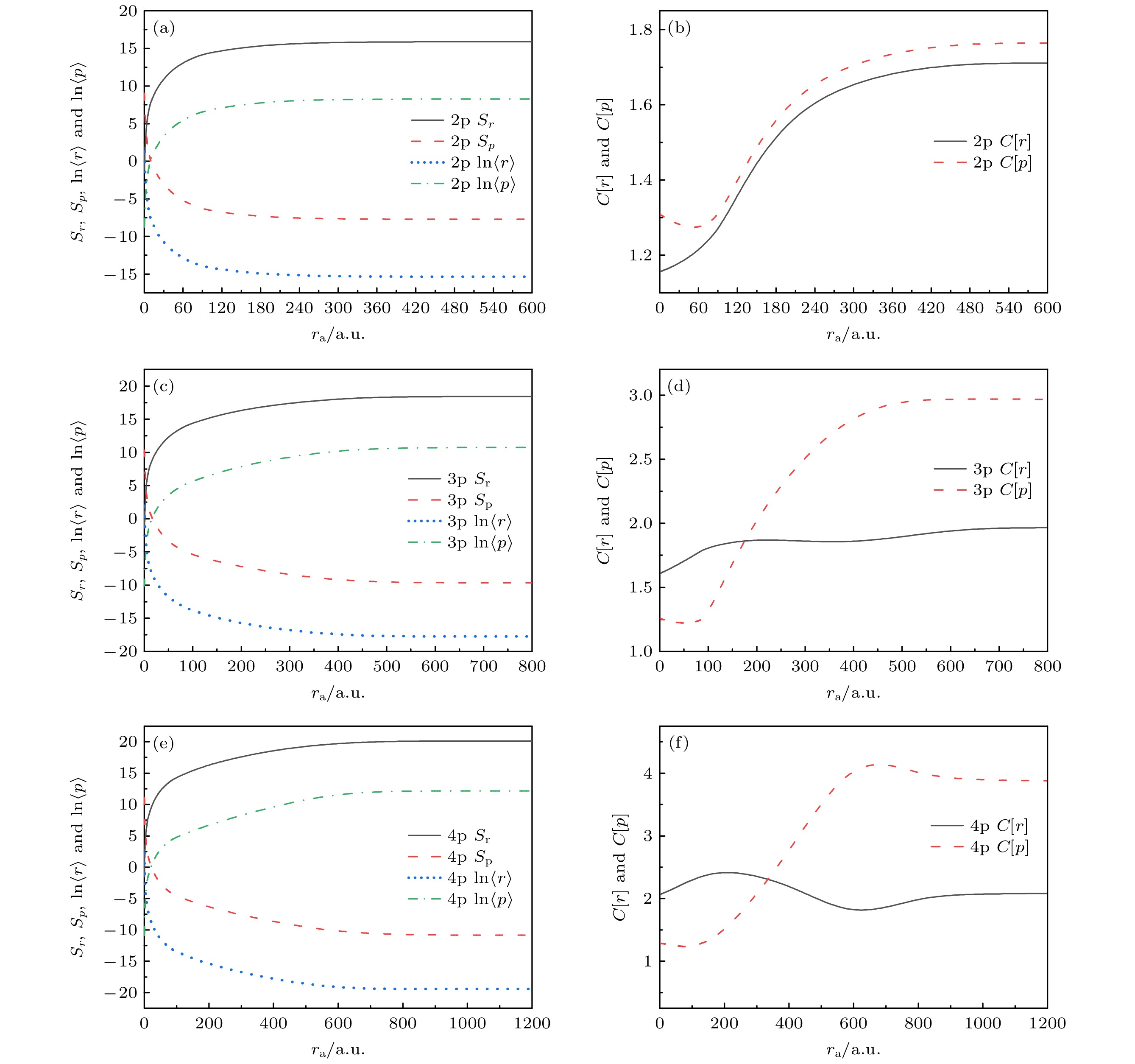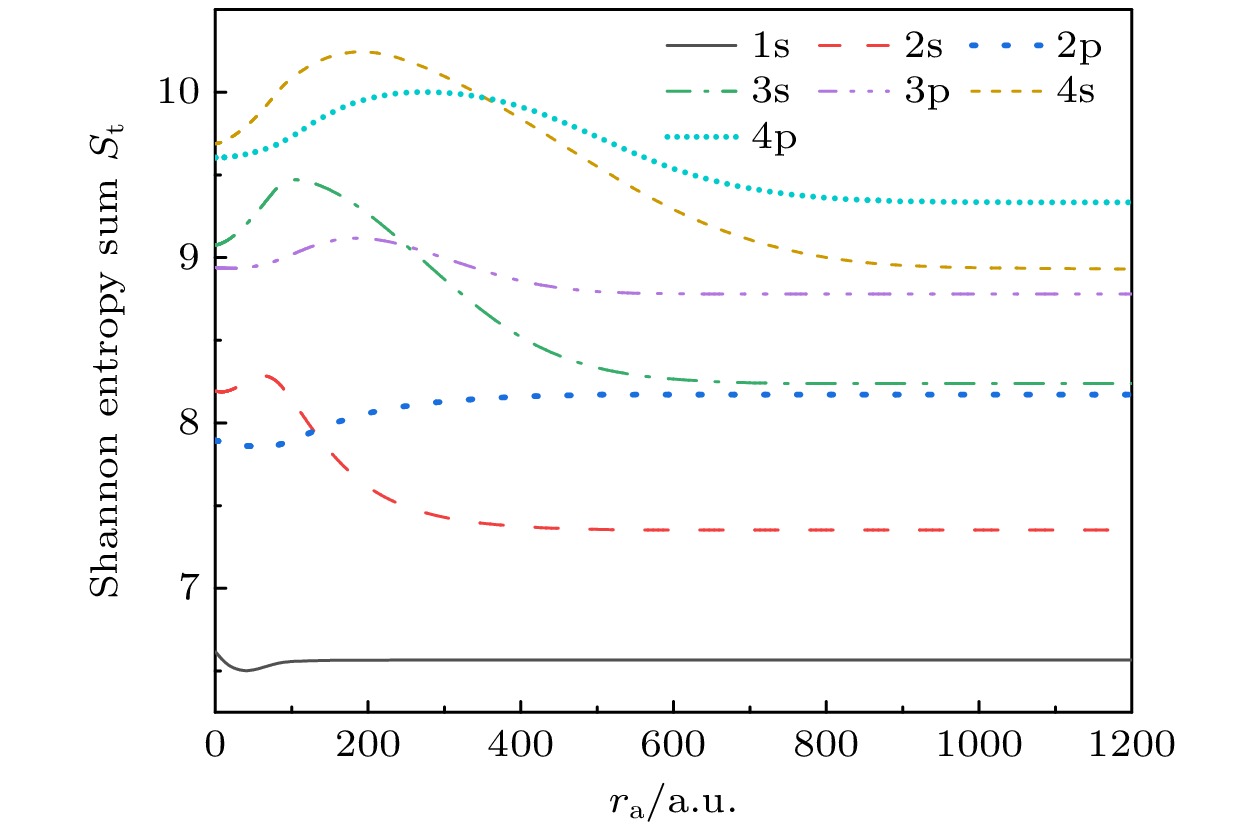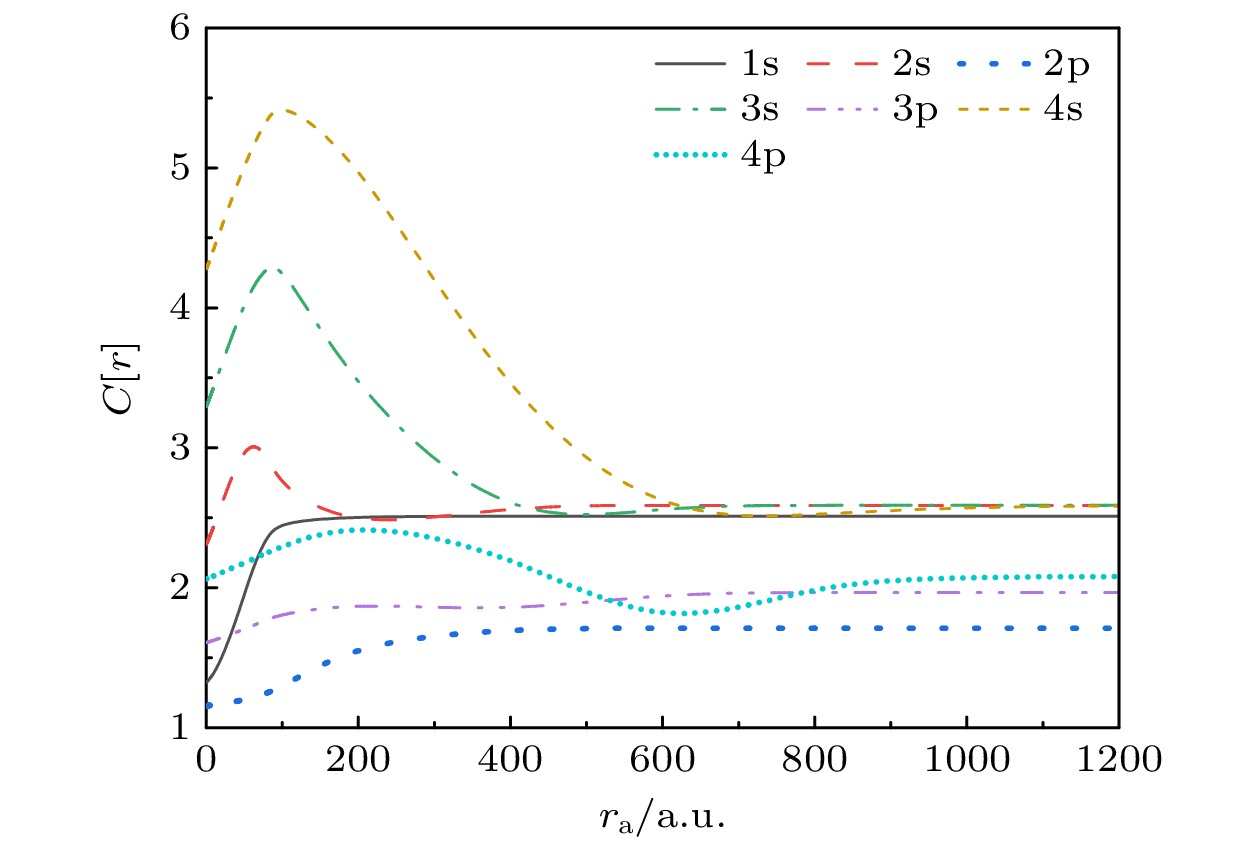-
The research on the disorder of quantum system plays a very important role in the field of quantum information, and has received much attention from theoretical and experimental researchers. However, it is very difficult to study the disorder of atoms trapped in microcavity due to their complex nonlocal space-time evolution characteristics. To solve this problem, we present a method to study the internal disorder of hydrogenic atoms trapped in microcavity, that is, to characterize and investigate the disorder of the confined system by using the quantum information entropy and shape complexity of the system. The Shannon information entropy and shape complexity in position space and momentum space (Sr, Sp, C[r], C[p]) are calculated and analyzed for different quantum states of hydrogenic atom in InN dielectric spherical microcavity, and pay special attention to the exploration of the influence of quantum confinement effect on the disorder of the system. The results show that when the radius of the spherical microcavity is very small, the quantum confinement effect is more significant, and a series of extreme points appears in the shape complexity curve of the system, which is caused by the joint interaction of information entropy and spatial inhomogeneity. With the increase of the radius of the spherical cavity, the effect of quantum confinement is weakened, and the Shannon information entropy and shape complexity of the confined hydrogenic atom are similar to the counterparts of the hydrogenic atom in free space. Our work provides an effective method to study the internal disorder of a confined quantum. This work provides an effective method for studying the internal disorder of confined quantum systems and presents some references for the information measurement of confined quantum systems.
-
Keywords:
- Shannon information entropy /
- shape complexity /
- quantum confinement /
- InN dielectric spherical microcavity
[1] Connerade J P, Dolmatov V H, Lakshmi P A 2000 J. Phys. B: At. Mol. Opt. Phys. 33 251
 Google Scholar
Google Scholar
[2] Sabin J R, Brändas E J, Cruz S A 2009 The Theory of Confined Quantum Systems, Parts I and II, Advances in Quantum Chemistry (Vols. 57, 58) (Amsterdam: Academic Press) pp2–19
[3] Sen K D 2014 Electronic Structure of Quantum Confined Atoms and Molecules (Switzerland: Springer) pp1–253
[4] Wang D H, Zhang J, Sun Z P, Zhang S F, Zhao G 2021 Chem. Phys. 551 111331
 Google Scholar
Google Scholar
[5] Martínez-Sánchez M A, Vargas R, Garza J 2019 Quantum Rep. 1 208
 Google Scholar
Google Scholar
[6] Guerra D, Vargas R, Fuentealba P, Garza J 2009 Adv. Quantum Chem. 58 1
[7] Rodriguez-Bautista M, Díaz-García C, Navarrete-López A M, Vargas R, Garza J 2015 J. Chem. Phys. 143 034103
 Google Scholar
Google Scholar
[8] Porras-Montenegro N, Pe´rez-Merchancano S T 1992 Phys. Rev. B 46 9780
 Google Scholar
Google Scholar
[9] Şahin M 2008 Phys. Rev. B 77 045317
 Google Scholar
Google Scholar
[10] Yuan J H, Zhang Y, Guo X X, Zhang J J, Mo H 2015 Physica E 68 232
 Google Scholar
Google Scholar
[11] Wang D H, He X, Liu X, Chu B H, Liu W, Jiao M M 2022 Philos. Mag. 102 2302
 Google Scholar
Google Scholar
[12] Longo G M, Longo S, Giordano D 2015 Phys. Scr. 90 085402
 Google Scholar
Google Scholar
[13] Cottrell T L 1951 Trans. Faraday Soc. 47 337
 Google Scholar
Google Scholar
[14] Zhu J L, Xiong J J, Gu B L 1990 Phys. Rev. B 41 6001
 Google Scholar
Google Scholar
[15] Lopez-Rosa S, Manzano D, Dehesa J S 2009 Physica A 388 3273
 Google Scholar
Google Scholar
[16] Liu S 2007 J. Chem. Phys. 126 191107
 Google Scholar
Google Scholar
[17] Aquino N, Flores-Riveros A, Rivas-Silva J F 2013 Phys. Lett. A 377 2062
 Google Scholar
Google Scholar
[18] Sun G H, Popov D, Camacho-Nieto O, Dong S H 2015 Chin. Phys. B 24 100303
 Google Scholar
Google Scholar
[19] Najafizade S A, Hassanabadi H, Zarrinkamar S 2016 Chin. Phys. B 25 040301
 Google Scholar
Google Scholar
[20] Bialynicki-Birula I, Mycielski J 1975 Comm. Math. Phys. 44 129
 Google Scholar
Google Scholar
[21] Guevara N L, Sagar R P, Esquivel R O, 2003 J. Chem. Phys. 119 7030
 Google Scholar
Google Scholar
[22] Fuentealba P, Melin J 2002 Int. J. Quantum Chem. 90 334
 Google Scholar
Google Scholar
[23] López-Ruiz R, Mancini H L, Calbet X 1995 Phys. Lett. A 209 321
 Google Scholar
Google Scholar
[24] Calbet X, López-Ruiz R 2001 Phys. Rev. E 63 066116
 Google Scholar
Google Scholar
[25] Angulo J C, Antolín J 2008 J. Chem. Phys. 128 164109
 Google Scholar
Google Scholar
[26] Majumdar S, Mukherjee N, Roy A K 2017 Chem. Phys. Lett. 687 322
 Google Scholar
Google Scholar
[27] 梁双, 吕燕伍 2007 56 1617
 Google Scholar
Google Scholar
Liang S, Lv Y W 2007 Acta Phys. Sin. 56 1617
 Google Scholar
Google Scholar
[28] Mata M, Zhou X, Furtmayr F, et al. 2013 J. Mater. Chem. C 1 4300
 Google Scholar
Google Scholar
[29] Guo Y, Pan F, Ren Y J, et al. 2018 Phys. Chem. Chem. Phys. 20 24239
 Google Scholar
Google Scholar
[30] Li P, David A, Li H, et al. 2021 Appl. Phys. Lett. 119 231101
 Google Scholar
Google Scholar
[31] Binks D J, Dawson P, Oliver R A, Wallis D J 2022 Appl. Phys. Rev. 9 041309
 Google Scholar
Google Scholar
[32] Chang C, Li X C 2022 Eur. Phys. J. D. 76 134
 Google Scholar
Google Scholar
[33] González-Férez R, Dehesa J S, Patil S H, Sen K D 2009 Physica A 388 4919
 Google Scholar
Google Scholar
-
图 3 囚禁在InN电介质球形微腔和真空球形微腔中氢原子的1s态的香农信息熵和形状复杂度随半径的变化 (a)位置空间和动量空间中的香农信息熵Sr和Sp; (b) 位置空间和动量空间的平均电子概率密度ln
$\langle r \rangle$ 和ln$ \langle p \rangle $ ; (c) 位置空间的形状复杂度C [r]; (d)动量空间中的形状复杂度C [p]Figure 3. Shannon information entropy and shape complexity as a function of the radius of the microcavity for the 1 s state of the hydrogen atom confined in the InN dielectric spherical microvavtiy and vacuum spherical microcavity: (a) Shannon information entropy in the position space Sr and in the momentum space Sp; (b) averaging electron probability density in the position space ln
$\langle r \rangle$ and in the momentum space ln$ \langle p \rangle $ ; (c) shape complexity in the position space C [r]; (d) shape complexity in the momentum space C [p].图 4 囚禁在InN电介质球形微腔中和真空球形微腔中氢原子的2s态的香农信息熵和形状复杂度随微腔半径的变化曲线 (a) Sr,Sp, ln
$\langle r \rangle$ 和ln$\langle p \rangle $ 随ra的变化曲线; (b)在位置空间和动量空间中形状复杂度C [r]和C [p]随ra的变化曲线Figure 4. Shannon information entropy and shape complexity as a function of the radius of the microcavity for the 2s state of the hydrogen atom confined in the InN dielectric spherical microvavtiy and vacuum spherical microcavity: (a) Variation of Sr, Sp, ln
$\langle r \rangle$ and ln$\langle p \rangle $ with ra; (b) variation of shape complexity in the position space C [r] and in the momentum space C [p] with ra.图 5 囚禁在InN电介质球形微腔中氢原子的3s态和4s态的香农信息熵和形状复杂度随微腔半径的变化曲线 (a) 3s态Sr, Sp, ln
$\langle r \rangle$ 和ln$\langle p \rangle $ 随ra的变化; (b) 3s态的C [r]和C [p]随ra的变化; (c) 4s态Sr, Sp, ln$\langle r \rangle$ 和ln$ \langle p \rangle $ 随ra的变化; (d) 4s态的C [r]和C [p]随ra的变化Figure 5. Shannon information entropy and shape complexity as a function of the radius of the InN dielectric spherical microcavity for the 3s state and 4s state: (a) Variation of Sr, Sp, ln
$\langle r \rangle$ and ln$\langle p \rangle $ with ra for the 3s state; (b) variation of C [r] and C [p] with ra for the 3s state; (c) variation of Sr, Sp, ln$\langle r \rangle$ and ln$\langle p \rangle $ with ra for the 4s state; (d) variation of C [r] and C [p] with ra for the 4s state.图 6 囚禁在InN电介质球形微腔中氢原子的2p, 3p和4p态的香农信息熵和形状复杂度随微腔半径的变化 (a) 2p态Sr, Sp, ln
$\langle r \rangle$ 和ln$\langle p \rangle $ 随ra的变化; (b) 2p态C [r]和C [p]随ra的变化; (c) 3p态Sr, Sp, ln$\langle r \rangle$ 和ln$\langle p\rangle $ 随ra的变化; (d) 3p态C [r]和C [p]随ra的变化; (e) 4p态Sr, Sp, ln$ \langle r \rangle $ 和ln$\langle p\rangle $ 随ra的变化; (f) 4p态C [r]和C [p]随ra的变化Figure 6. Shannon information entropy and shape complexity as a function of the radius of the InN dielectric spherical microcavity for the 2p, 3p and 4p states: (a) Variation of Sr, Sp, ln
$ \langle r \rangle $ and ln$\langle p \rangle $ with ra for the 2p state; (b) variation of C [r] and C [p] with ra for the 2p state; (c) variation of Sr, Sp, ln$ \langle r \rangle $ and ln$\langle p \rangle $ with ra for the 3p state; (d) variation of C [r] and C [p] with ra for the 3p state; (e) variation of Sr, Sp, ln$ \langle r \rangle $ and ln$\langle p \rangle $ with ra for the 4p state; (f) variation of C [r] and C [p] with ra for the 4p state.表 1 InN电介质球形微腔中氢原子在不同囚禁半径下的前几个态的本征能
Table 1. Intrinsic energy of the first few states of hydrogen atoms at different confinement radii in InN dielectric spherical microcavity.
ra/a.u. 0.5 10 30 50 100 200 300 500 1s 19.42009 0.03291 –0.00042 –0.00192 –0.00213 –0.00214 –0.00214 –0.00214 2s 78.54949 0.17680 0.01493 0.00365 –0.00011 –0.00053 –0.00053 –0.00053 2p 40.13943 0.08877 0.00709 0.00152 –0.00032 –0.00053 –0.00053 –0.00053 3s 177.19306 0.42100 0.04155 0.01305 0.00208 –0.00001 –0.00021 –0.00024 3p 119.05181 0.28297 0.02797 0.00880 0.00138 –0.00007 –0.00022 –0.00024 3d 66.22135 0.15538 0.01486 0.00447 0.00056 –0.00016 –0.00023 –0.00024 4s 315.33012 0.76461 0.07935 0.02653 0.00536 0.00074 0.00009 –0.00012 4p 237.44938 0.57693 0.06017 0.02023 0.00415 0.00057 0.00005 –0.00012 4d 165.17213 0.40025 0.04149 0.01385 0.00277 0.00034 –0.00001 –0.00013 4f 97.46420 0.23423 0.02381 0.00777 0.00143 0.00010 –0.00008 –0.00013 表 2 囚禁在InN电介质球形微腔中氢原子1s, 2s, 3s和4s态在位置和动量空间中的香农信息熵和形状复杂度随半径的变化
Table 2. Variation of Shannon information entropy and shape complexity in the position and momentum spaces of 1s, 2s, 3s and 4s states for hydrogenic atom confined in the InN dielectric spherical microcavity as a function of the radius of the microcavity.
ra/a.u. 0.5 2 4 6 10 40 100 400 1000 1500 1s Sr –1.4078 2.7388 4.8012 5.9998 6.8441 7.4938 11.2125 12.3083 12.3283 12.3283 Sp 8.0224 3.8677 1.7946 0.5856 0.2690 –0.9287 –4.7199 –5.7473 –5.7617 –5.7617 C [r] 1.3238 1.3331 1.3463 1.3604 1.3754 1.3915 1.7729 2.4742 2.5107 2.5107 C [p] 1.5156 1.5110 1.5053 1.5002 1.4959 1.4924 1.6081 2.3007 2.3545 2.3545 2s Sr –1.6182 2.5393 4.6173 5.8324 6.6945 7.3633 11.5600 14.5011 16.2944 16.2945 Sp 9.8106 5.6517 3.5722 2.3561 1.4934 0.8246 –3.3163 –6.3549 –8.9410 –8.9411 C [r] 2.3122 2.3318 2.3584 2.3857 2.4135 2.4420 2.8872 2.6978 2.5882 2.5883 C [p] 1.2987 1.2991 1.3004 1.3027 1.3059 1.3104 1.6255 3.5705 3.5862 3.5862 3s Sr –1.6941 2.4651 4.5451 5.7622 6.6260 7.2964 11.4868 14.3744 18.4189 18.6100 Sp 10.7698 6.6122 4.5347 3.3205 2.4598 1.7931 –2.2946 –4.8614 10.0304 10.3718 C [r] 3.2965 3.3183 3.3476 3.3772 3.4071 3.4372 3.8912 4.3150 2.4249 2.5897 C [p] 1.2959 1.2934 1.2900 1.2866 1.2833 1.2802 1.2566 1.6164 4.9245 5.3478 4s Sr –1.7332 2.4264 4.5068 5.7242 6.5883 7.2589 11.4435 14.2816 18.7984 20.2300 Sp 11.4216 7.2638 5.1857 3.9710 3.1098 2.4425 –1.6559 –4.1749 –8.9360 11.2692 C [r] 4.2798 4.3022 4.3323 4.3624 4.3927 4.4230 4.8733 5.4856 3.3059 2.5188 C [p] 1.3205 1.3193 1.3173 1.3153 1.3134 1.3115 1.2917 1.3738 3.2785 7.1624 表 3 InN电介质球形微腔中氢原子2p, 3p和4p态位置空间和动量空间中的香农信息熵和形状复杂度
Table 3. Shannon information entropy and shape complexity of 2p, 3p and 4p states in the position space and momentum space for hydrogen atom confined in the InN dielectric spherical microcavity.
ra/a.u. 0.5 2 4 6 10 40 100 400 1000 1500 2p Sr –1.1279 3.0287 5.1050 6.3181 7.8439 11.9414 14.4765 15.8804 15.8804 15.8804 Sp 9.0214 4.8633 2.7851 1.5697 0.0398 –4.0817 –6.5889 –7.7092 –7.7092 –7.7092 C [r] 1.1568 1.1577 1.1589 1.1602 1.1628 1.1887 1.2918 1.7107 1.7107 1.7107 C [p] 1.3084 1.3068 1.3049 1.3024 1.2982 1.2749 1.3281 1.7639 1.7639 1.7639 3p Sr –1.3920 2.7660 4.8442 6.0595 7.5896 11.7333 14.4737 18.2711 18.4214 18.4214 Sp 10.3320 6.1733 4.0942 2.8783 1.3468 –2.7953 –5.4546 –9.4770 –9.6406 –9.6406 C [r] 1.6088 1.6113 1.6148 1.6183 1.6254 1.6833 1.8150 1.8267 1.9657 1.9657 C [p] 1.2564 1.2547 1.2526 1.2506 1.2465 1.2240 1.2749 2.9511 2.9671 2.9671 4p Sr –1.5141 2.6444 4.7234 5.9394 7.4711 11.6261 14.3794 18.7629 20.1488 20.1494 Sp 11.1181 6.9596 4.8808 3.6652 2.1344 –2.0027 –4.6540 –8.7725 10.8158 10.8150 C [r] 2.0644 2.0676 2.0719 2.0762 2.0850 2.1533 2.2977 2.2520 2.0817 2.0829 C [p] 1.2878 1.2862 1.2845 1.2827 1.2791 1.2542 1.2288 2.7123 3.8746 3.8744 -
[1] Connerade J P, Dolmatov V H, Lakshmi P A 2000 J. Phys. B: At. Mol. Opt. Phys. 33 251
 Google Scholar
Google Scholar
[2] Sabin J R, Brändas E J, Cruz S A 2009 The Theory of Confined Quantum Systems, Parts I and II, Advances in Quantum Chemistry (Vols. 57, 58) (Amsterdam: Academic Press) pp2–19
[3] Sen K D 2014 Electronic Structure of Quantum Confined Atoms and Molecules (Switzerland: Springer) pp1–253
[4] Wang D H, Zhang J, Sun Z P, Zhang S F, Zhao G 2021 Chem. Phys. 551 111331
 Google Scholar
Google Scholar
[5] Martínez-Sánchez M A, Vargas R, Garza J 2019 Quantum Rep. 1 208
 Google Scholar
Google Scholar
[6] Guerra D, Vargas R, Fuentealba P, Garza J 2009 Adv. Quantum Chem. 58 1
[7] Rodriguez-Bautista M, Díaz-García C, Navarrete-López A M, Vargas R, Garza J 2015 J. Chem. Phys. 143 034103
 Google Scholar
Google Scholar
[8] Porras-Montenegro N, Pe´rez-Merchancano S T 1992 Phys. Rev. B 46 9780
 Google Scholar
Google Scholar
[9] Şahin M 2008 Phys. Rev. B 77 045317
 Google Scholar
Google Scholar
[10] Yuan J H, Zhang Y, Guo X X, Zhang J J, Mo H 2015 Physica E 68 232
 Google Scholar
Google Scholar
[11] Wang D H, He X, Liu X, Chu B H, Liu W, Jiao M M 2022 Philos. Mag. 102 2302
 Google Scholar
Google Scholar
[12] Longo G M, Longo S, Giordano D 2015 Phys. Scr. 90 085402
 Google Scholar
Google Scholar
[13] Cottrell T L 1951 Trans. Faraday Soc. 47 337
 Google Scholar
Google Scholar
[14] Zhu J L, Xiong J J, Gu B L 1990 Phys. Rev. B 41 6001
 Google Scholar
Google Scholar
[15] Lopez-Rosa S, Manzano D, Dehesa J S 2009 Physica A 388 3273
 Google Scholar
Google Scholar
[16] Liu S 2007 J. Chem. Phys. 126 191107
 Google Scholar
Google Scholar
[17] Aquino N, Flores-Riveros A, Rivas-Silva J F 2013 Phys. Lett. A 377 2062
 Google Scholar
Google Scholar
[18] Sun G H, Popov D, Camacho-Nieto O, Dong S H 2015 Chin. Phys. B 24 100303
 Google Scholar
Google Scholar
[19] Najafizade S A, Hassanabadi H, Zarrinkamar S 2016 Chin. Phys. B 25 040301
 Google Scholar
Google Scholar
[20] Bialynicki-Birula I, Mycielski J 1975 Comm. Math. Phys. 44 129
 Google Scholar
Google Scholar
[21] Guevara N L, Sagar R P, Esquivel R O, 2003 J. Chem. Phys. 119 7030
 Google Scholar
Google Scholar
[22] Fuentealba P, Melin J 2002 Int. J. Quantum Chem. 90 334
 Google Scholar
Google Scholar
[23] López-Ruiz R, Mancini H L, Calbet X 1995 Phys. Lett. A 209 321
 Google Scholar
Google Scholar
[24] Calbet X, López-Ruiz R 2001 Phys. Rev. E 63 066116
 Google Scholar
Google Scholar
[25] Angulo J C, Antolín J 2008 J. Chem. Phys. 128 164109
 Google Scholar
Google Scholar
[26] Majumdar S, Mukherjee N, Roy A K 2017 Chem. Phys. Lett. 687 322
 Google Scholar
Google Scholar
[27] 梁双, 吕燕伍 2007 56 1617
 Google Scholar
Google Scholar
Liang S, Lv Y W 2007 Acta Phys. Sin. 56 1617
 Google Scholar
Google Scholar
[28] Mata M, Zhou X, Furtmayr F, et al. 2013 J. Mater. Chem. C 1 4300
 Google Scholar
Google Scholar
[29] Guo Y, Pan F, Ren Y J, et al. 2018 Phys. Chem. Chem. Phys. 20 24239
 Google Scholar
Google Scholar
[30] Li P, David A, Li H, et al. 2021 Appl. Phys. Lett. 119 231101
 Google Scholar
Google Scholar
[31] Binks D J, Dawson P, Oliver R A, Wallis D J 2022 Appl. Phys. Rev. 9 041309
 Google Scholar
Google Scholar
[32] Chang C, Li X C 2022 Eur. Phys. J. D. 76 134
 Google Scholar
Google Scholar
[33] González-Férez R, Dehesa J S, Patil S H, Sen K D 2009 Physica A 388 4919
 Google Scholar
Google Scholar
Catalog
Metrics
- Abstract views: 5357
- PDF Downloads: 99
- Cited By: 0















 DownLoad:
DownLoad:




































